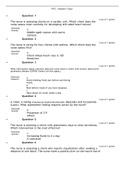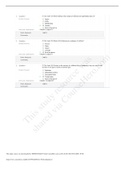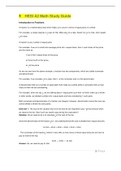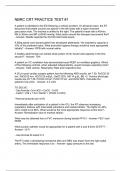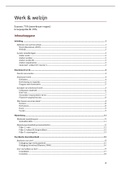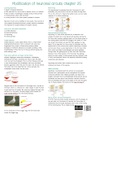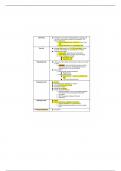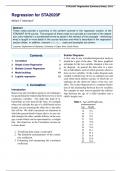PYC3703
COGNITION: THINKING, MEMORY & PROBLEM SOLVING
Table of Contents
ABBREVIATIONS & INFO KEY ............................................................................................................................................ 2
CHAPTER 1 - INTRODUCTION TO COGNITIVE PSYCHOLOGY ........................................................................................... 3
CHAPTER 2 - COGNITIVE NEUROSCIENCE ........................................................................................................................ 9
CHAPTER 3 - PERCEPTION............................................................................................................................................... 15
CHAPTER 4: ATTENTION IS NOT REQUIRED ........................................................................................................... 23
CHAPTER 5 - SHORT-TERM & WORKING MEMORY ....................................................................................................... 24
CHAPTER 6 - LONG-TERM MEMORY: STRUCTURE......................................................................................................... 33
CHAPTER 7 - LONG-TERM MEMORY: ENCODING, RETRIEVAL & CONSOLIDATION ...................................................... 41
CHAPTER 8 - EVERYDAY MEMORY & MEMORY ERRORS .............................................................................................. 48
CHAPTER 9: KNOWLEDGE, CHAPTER 10: VISUAL IMAGERY & CHAPTER 11: LANGUAGE ARE NOT REQUIRED .. 55
CHAPTER 12 - PROBLEM SOLVING ................................................................................................................................. 56
CHAPTER 13 - JUDGEMENT, REASONING & DECISIONS ................................................................................................ 64
GLOSSARY OF TERMS ..................................................................................................................................................... 70
L.Smith Page.1
,2021S01 PYC3703 SUMMARY
ABBREVIATIONS & INFO KEY
ABBREVIATION MEANING
abcd Word / Phrase defined in the Glossary of Terms
NOTE: Press Ctrl+click on these words / phrases to skip to the definition in the Glossary of Terms
abcd Definitions & additional info obtained from online web sources
AI Artificial Intelligence
AP Action Potential
beh Behaviour(al)
BUP Bottom-Up Processing
CN Cognitive Neuroscience
CP Cognitive Psychology
CRT Choice Reaction Time
Eg. Example (for example)
exp Experience
IPA Information-Processing Approach
ito In Terms Of
LTM Long-term Memory
NS Nervous System
NT Neurotransmitter
OST Operation Span Task
PFC Prefrontal Cortex
Phys Physiological
Psy Psychology
re regarding
RST Reading Span Task
SM Sensory Memory
SRT Simple Reaction Time
STM Short-term Memory
TDP Top-Down Processing
L.Smith Page.2
, 2021S01 PYC3703 SUMMARY
CHAPTER 1 - INTRODUCTION TO COGNITIVE PSYCHOLOGY
~CP is the branch of Psy concerned with the scientific study of the mind~
What is the mind?
-Cognition:
Creates and controls mental functions such as perception, attention, memory, emotions, language, deciding, thinking and reasoning.
-Operation and function:
A system that created representations of the world so that we can act within it to achieve our goals
-Normal functioning & survival
Routine actions (recognising someone, having a conversation) involve many sophisticated qualities and complex operations.
Studying the Mind: Early work in CP
Decision-Making Time
Franciscus Donders (1868) - Pioneering experiment: Decision-making time
a. Simple Reaction Time
After a stimulus is presented the mind perceives it (mental response)
This leads to a certain reaction (behavioural response)
EXPERIMENT
b. Choice Reaction Time [CRT]
After a stimulus is presented the mind perceives it (1st mental response)
The stimulus type must be determined and decision made to react appropriately (2nd mental response)
Appropriate reaction takes place (behavioural response)
-Result: Response takes during CRT task as during SRT task (extra step).
*The decision-making process takes about 100ms
**Mental responses cannot be measured directly but has to be inferred from behaviour
Structuralism & Analytic Introspection
-Wilhelm Wundt (1879)
Structuralism: Overall experience is determined by combining basic elements of experience (sensations)
-Periodic Table of the Mind
Summary of basic sensations involved in creating complex experience
-Analytic introspection
Trained participants describing their sensations, feelings & thought processes in response to stimuli
Empiricist approach (Empiricism)
Time course of forgetting
Hermann Ebbinghaus (1885): Memory retention
EXPERIMENT
-Quantitive method in determining how rapidly info is learned and lost over time
Original Learning time [OLT] taken for initial earning of a list (recalling correctly)
Waiting period (delay)
Re-learning time [RLT] taken to re-learn the same list (forgetting has occurred)
-Result: Memory drops rapidly 1st two days after initial learning, then levels off
*Memory can be quantified
*Curve can describe a property of the mind: ability to retain info
L.Smith Page.3
, 2021S01 PYC3703 SUMMARY
-Savings
Amount of info retained after a particular delay
S = OT – RLT
Longer delays result in smaller savings
Reduction of savings provides a measure of forgetting
Attention
-William James (1890) – Principles of Psychology
Attention influenced by interest
Paying attention to something implies withdrawing from others
Incl. thinking, consciousness, attention, memory, perception, imagination & reasoning
**Perceptive observation regarding attention & wide range of experiences
Abandoning the study of the mind
-Focus shift to pure observable behaviour
-Strict study of stimulus-response / input-output relationships
Behaviourism
-John Watson (1913)
Consideration of behaviour (observable)
Not consciousness (unobservable)
**Objective, experimental prediction and control of behaviour
in response to external stimuli
-Deficiencies in analytic introspection
Results extremely variable & difficult to verify
Requires extensive training
-Classical Conditioning (Pavlov, 1902)
How pairing one stimulus with another affects behaviour
Physiological & mental processes irrelevant
-Operant Conditioning (BF Skinner, 1938)
Stimulus-response relationship
o Positive = food, social approval
o Negative = shock, social rejection
**Behaviour is strengthened by the presentation of positive
reinforcers / withdrawal of negative reinforcers
-Critique
People respond to different aspects of the same stimulus event
Aspect not known until after response is made
Response dependent on meaning stimulus has to each individual
Setting the stage for re-emergence of the mind in psy
Development of a cognitive map
-Edward Tolman (1948)
Rejects stimulus-response theory
o Reinforcement not necessary for learning to occur
o Individuals do more than merely respond to stimuli
o They act on beliefs, attitudes & changing conditions
**Forming of a cognitive concept when striving towards a certain goal
L.Smith Page.4


